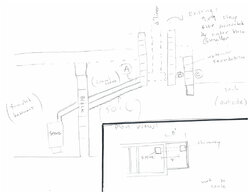Hello all,
First time poster with questions on a wood stove install into a basement.
The stove I'm installing is a Drolet HT2000.The stove calls for 6 in. flue. Since the chimney is much bigger (9x9 clay lined), I will be looking to install a liner. and I have two important issues to sort out: (a) I would like to go with a solid liner (b) I would like to make cleaning the flue as easy as possible.
This is a (very rough) sketch of what things look like.

As you can hopefully make out from my sketch, the piping for the stove starts out in the finished basement and then goes through a crawl space. The slope is exaggerated in my sketch but you get the idea.
The piping will connect to the chimney (shown this connection point as A on the sketch).
I will be meeting with a chimney installer to discuss my options but I wanted to ask here as well:
As I said, I'd like to go with the solid liner option. the 9x9 clay flue is straight and in good shape so I'm hoping I can drop a solid liner in without much problem.
I would also like to know if it would it be possible for me to open up an access point opposite of the connecting point A? That is, can I open the back side of the chimney (shown in diagram as B and C)? That would require me to go through (first) the outer block foundation (C, which is not a problem) and then through the back wall of the chimney (point B). The chimney is (small) cinder block on the outside and the clay liner on the inside. I would like to build in a clean out to facilitate Spring cleaning and make the installation process easier. Does that sound doable?
I hope my sketch makes sense to all as getting pics of this is pretty difficult.
(note: I didn't show it on the sketch but the chimney is approx 24 feet high).
Thanks everyone
First time poster with questions on a wood stove install into a basement.
The stove I'm installing is a Drolet HT2000.The stove calls for 6 in. flue. Since the chimney is much bigger (9x9 clay lined), I will be looking to install a liner. and I have two important issues to sort out: (a) I would like to go with a solid liner (b) I would like to make cleaning the flue as easy as possible.
This is a (very rough) sketch of what things look like.

As you can hopefully make out from my sketch, the piping for the stove starts out in the finished basement and then goes through a crawl space. The slope is exaggerated in my sketch but you get the idea.
The piping will connect to the chimney (shown this connection point as A on the sketch).
I will be meeting with a chimney installer to discuss my options but I wanted to ask here as well:
As I said, I'd like to go with the solid liner option. the 9x9 clay flue is straight and in good shape so I'm hoping I can drop a solid liner in without much problem.
I would also like to know if it would it be possible for me to open up an access point opposite of the connecting point A? That is, can I open the back side of the chimney (shown in diagram as B and C)? That would require me to go through (first) the outer block foundation (C, which is not a problem) and then through the back wall of the chimney (point B). The chimney is (small) cinder block on the outside and the clay liner on the inside. I would like to build in a clean out to facilitate Spring cleaning and make the installation process easier. Does that sound doable?
I hope my sketch makes sense to all as getting pics of this is pretty difficult.
(note: I didn't show it on the sketch but the chimney is approx 24 feet high).
Thanks everyone

